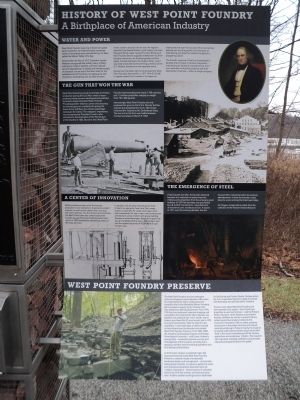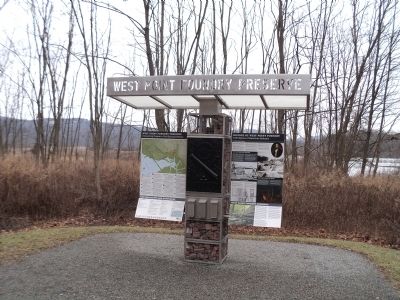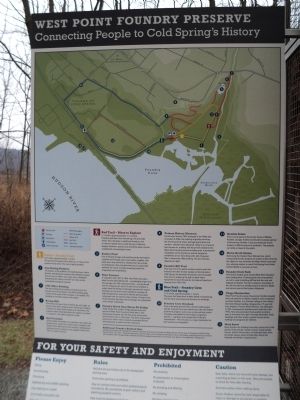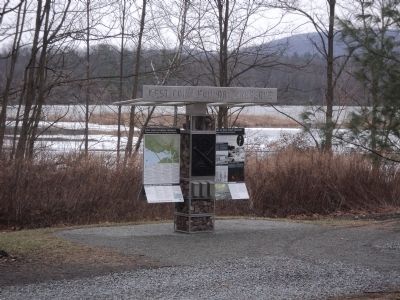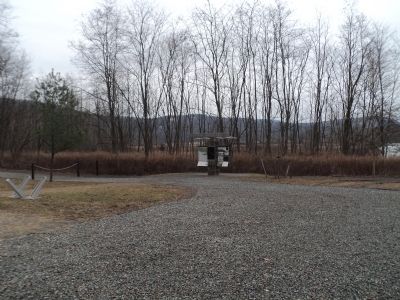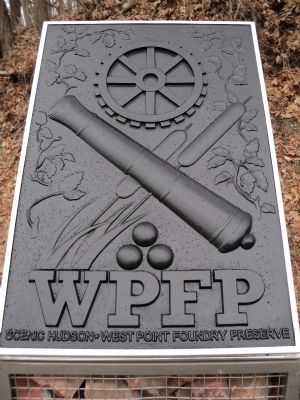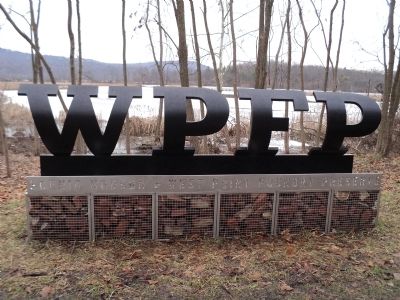Cold Spring in Putnam County, New York — The American Northeast (Mid-Atlantic)
History of West Point Foundry
A Birthplace of American Industry
Water and Power
West Point Foundry was one of America’s great early ironworks. An internationally renowned center of innovation and manufacturing, it’s been called the Silicon Valley of its day.
Shortly after the War of 1812, President James Madison recognized that quality heavy artillery was key to modern warfare, and that national security depended on a steady and reliable supply of ordnance. He set out to find four sites for the establishment of foundries to supply guns and munitions. Cold Spring was an ideal location: It was close to sources of iron ore; the region’s abundant hardwood forests could supply charcoal; Margaret Brook (later named Furnace Brook and then Foundry Brook) supplied waterpower to drive foundry machinery; its finished goods could be easily transported down the Hudson River; and it was well-protected by the looming presence of the U.S. Military Academy on the opposite shore.
Gouverneur Kemble (right) incorporated the West Point Foundry Association in 1817. With $100,000 in capital raised from investors, he began an enterprise that over the course of the next century defined not only the growth and character of Cold Spring, but also the industrial might of a prospering nation.
The foundry was one of the first businesses to develop the principle of vertical integration – maintaining all facets of manufacturing, from raw materials to finished products and their distribution channels – within a single company.
The Gun that Won the War
West Point Foundry proved its strength at military production during the Civil War, when it mass-produced rifled cannons developed and patented by foundry Superintendent Robert Parrott. Providing greater distance, power and accuracy, the Parrott guns are credited with giving the Union Army and Navy the military advantage necessary for victory. The weapons’ importance was recognized by President Lincoln, who witnessed a demonstration of the Parrott gun at the foundry in 1862. By war’s end, West Point Foundry had manufactured nearly 1,700 cannons and 1.3 million projectiles ranging in weight from 10 to 300 pounds.
Interestingly, West Point Foundry not only produced the guns on the U.S.S. Monitor but the engines that propelled the U.S.S. Merrimack, renamed the Virginia by the Confederate Navy. The two met in the first-ever battle between ironclad warships on March 9, 1862.
A Center of Innovation
Military ordnance was not all the foundry produced. It won contracts to manufacture steam engines, as well as the nation’s first iron ship, the cutter Spencer. The first American locomotive, the Best Friend, also was constructed at the foundry, as was the record-setting Experiment, which in 1832 reached the astonishing speed of 80 miles per hour.
In addition, the foundry manufactured miles of cast-iron piping for New York’s water system, machinery for cotton and sugar mills, and components for use in cast iron furniture and architecture, some of which still grace building facades in lower Manhattan today. At its peak, the foundry employed more than 1,000 workers and had the capacity to produce 10,000 tons of cast iron per year.
The Emergence of Steel
Following the Civil War, the foundry declined because of a reduction in orders from the military and competition from the emerging steel industry. In 1897 the business was purchased by J.B. & W.W. Cornell & Co., manufacturers of machinery and architectural iron. It closed in 1911; over the ensuing decades, the site housed other industries before its eventual abandonment. In time the foundry’s ruins became woven among the forest seen today.
All images, except where noted, from the collection of the Putnam History Museum.
West Point Foundry Preserve
The West Point Foundry site has undergone profound changes in recent decades. After years of contamination by heavy-metal poisoning, caused by the former Marathon Battery Company plant (located on nearby land), Foundry Cove was declared an EPA Superfund site. From 1994-1996 the
cove underwent extensive dredging and remediation that restored the tidal wetlands, key habitats and, gradually, the river’s health. Scenic Hudson purchased the 87-acre foundry site in 1996 to ensure its protection. With the help of many volunteers, it removed heaps of debris dumped on the property over the decades and created West Point Foundry Preserve. From 2001-2008, the Industrial Archaeology Program at Michigan Technological University – with Scenic Hudson’s sponsorship – conducted intensive surveys and investigations of the foundry’s surviving ruins, opening a window onto its evolving operations and Cold Spring’s early history.
In 2013 Scenic Hudson completed major site improvements that make West Point Foundry Preserve a national model of sustainable landscape design and management – and provide lasting benefits. Its spacious gathering areas and innovative interpretive elements serve as an “outdoor classrooms,” where lessons in industrial history, the Civil War and the environment come alive. It offers another exciting tourism destination in Cold Spring and Putnam County. Perhaps above all, it is a magnificent place to connect with the beauty and spiritual power of nature.
To learn more about West Point Foundry and see examples of its output – from Parrott gun projectiles to cast iron furniture – visit the Putnam History Museum, which features a permanent foundry exhibition as well as a research library containing archival material related to the ironworks. Founded in 1906 to collect, preserve and present to the public historical and cultural material pertaining to Putnam County, the museum is located at 63 Chestnut Street (stop 8 on the Red Trail) in the former schoolhouse built for foundry apprentices and employees’ children. The museum also organizes changing exhibitions and provides educational programming for the public.
Topics and series. This historical marker is listed in these topic lists: Industry & Commerce • War, US Civil • Waterways & Vessels. In addition, it is included in the Former U.S. Presidents: #04 James Madison, and the Former U.S. Presidents: #16 Abraham Lincoln series lists. A significant historical month for this entry is March 1972.
Location. 41° 24.9′ N, 73° 57.019′ W. Marker is in Cold Spring, New York, in Putnam County. Marker is on Kemble Avenue, on the left when traveling south. Marker is located near at the south end of the parking lot in the West Point Foundry Preserve. Touch for map. Marker is at or near this postal address: 68 Kemble Avenue, Cold Spring NY 10516, United States of America. Touch for directions.
Other nearby markers. At least 8 other markers are within walking distance of this marker. From Forest to Factory to Forest (about 600 feet away, measured in a direct line); The West Point Foundry (about 600 feet away); The West Point Foundry School (about 800 feet away); The 1865 Office Building (about 800 feet away); West Point Foundry Archaeological Site (approx. 0.2 miles away); Jewel of the Hudson (approx. 0.2 miles away); Joseph A. Percacciolo, Jr. (approx. 0.2 miles away); Boring Mill Overlook (approx. 0.2 miles away). Touch for a list and map of all markers in Cold Spring.
Also see . . . West Point Foundry Preserve. Scenic Hudson website. (Submitted on January 16, 2014, by Bill Coughlin of Woodland Park, New Jersey.)
Credits. This page was last revised on March 15, 2021. It was originally submitted on January 16, 2014, by Bill Coughlin of Woodland Park, New Jersey. This page has been viewed 864 times since then and 52 times this year. Last updated on March 9, 2021, by Carl Gordon Moore Jr. of North East, Maryland. Photos: 1, 2, 3, 4, 5, 6, 7. submitted on January 16, 2014, by Bill Coughlin of Woodland Park, New Jersey. • Bill Pfingsten was the editor who published this page.
